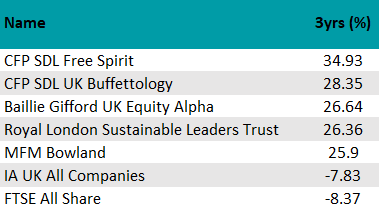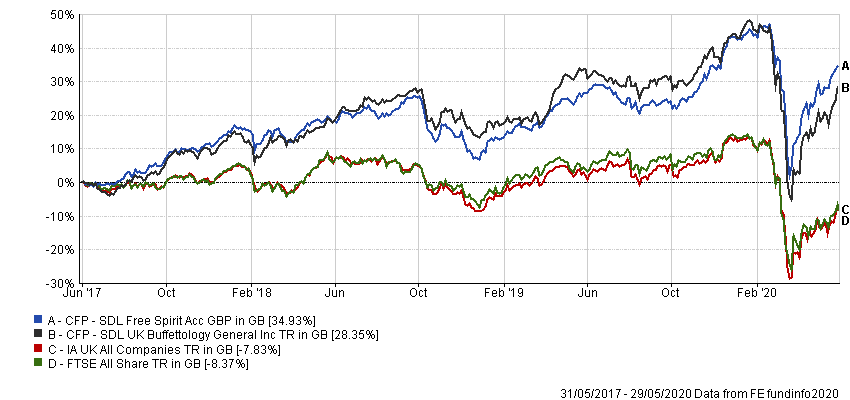The two “Buffettology” funds have taken first and second place in the IA UK All Companies sector in the three years to the end of May, with the £10m CFP SDL Free Spirit vehicle leapfrogging its better-known CFP SDL UK Buffettology stablemate in March’s volatility to take the top spot.
Both funds use the same “Business Perspective Investing” approach, which is based on the strategy of Berkshire Hathaway chairman Warren Buffett.
Best-performing funds over 3yrs vs sector and index

Source: FE Analytics
CFP SDL UK Buffettology’s manager Keith Ashworth-Lord said what this means in practice is that he and Andrew Vaughan, who runs CFP SDL Free Spirit, are not “investment analysts or securities analysts”.
“We’re business analysts – we try to get under the skin of the businesses we look at and find out what makes them special,” he explained.
“Quite simply, you’re not buying a gaming chip on a casino table when you buy a share in the stock market. You are buying a real economic interest in a real business. Therefore, all your effort should be directed at drilling down into that business.”
Ashworth-Lord and Vaughan begin by looking at a business’s growth characteristics, margin development, return on equity, cash conversion and balance sheet strength. They then use Porter’s Five Forces to analyse its position within an industry, which helps them to gauge the potential for new entrants into their market and whether their products may be substituted or become obsolete.
The managers also put a lot of effort into understanding the “bargaining power” of a company relative to its customers, which Vaughan said helped them out in the downturn of this year.
“You’ll find companies in both portfolios that have continued to generate revenues, because the customers are locked in in some way,” he explained.
“That might be things like software and media where their customers pay for annual subscriptions which they continue to need and use.
“Even in good times, we think it gives our businesses pricing power, which is what equity investments are all about. It’s that ability to keep the business growing above the rate of inflation.”
The funds have also been helped by high cash positions, which reached as high as 20 per cent in CFP SDL Free Spirit ahead of March. This was not part of a defensive strategy to protect against a crash, however, but relates to the managers’ rigid focus on valuation – which only comes into play when a business has met all the other criteria.
Rather than P/E (price to earnings) ratios, the managers attempt to model what cash flows businesses will provide in perpetuity, which they discount at 10 per cent a year.
“Then, if we’re being offered a bargain,” said Ashworth-Lord, “we’ll hit it for six. If we’re being offered fair value, we might well invest if we think the future is pretty predictable.
“If it’s overvalued, it’ll just sit on our watch list until either the market has a flunk, or something happens to the company which we think is evidently solvable but results in the share price tanking.”
To the outsider, it may look as if the managers take their focus on entry points to extreme levels. Vaughan took over CFP SDL Free Spirit in July last year, but although he sold out of three stocks, it wasn’t until March’s crash that he felt prices had come down far enough for him to make his first new portfolio additions: YouGov, Elecosoft and Intertek. It is the last stock in particular that highlights the managers’ uncompromising approach to valuations, with Vaughan following it for 15 years before he finally pulled the trigger.
“I’m sure Andrew won’t mind me telling you,” Ashworth-Lord continued, “but when we worked together as analysts at a publication 15 years ago, Intertek was one that Andrew looked at and passed up. He thinks it was one of the worst pass-ups ever.”
“It was indeed,” Vaughan replied. “It was 2005 and it seemed like quite a complex business, so I passed on it, but I’ve been watching it ever since. Even last summer when I had all that cash, I thought ‘you’ve waited this long, just wait a bit longer’. And the opportunity finally arrived.”
Although Ashworth-Lord deployed his net cash position into the market in March, he didn’t invest in any new holdings. There are three businesses he said he “would love to bring into Buff”, with two of these coming close to his target entry price in March, but they didn’t quite meet his criteria.
“When I say very close, I mean to within 10 per cent of what I was thinking would be the right level,” he explained.
“Very sadly, the market turned on 23 March and took off like a Falcon 9 rocket and they both went away. I’m afraid to say one of them is hitting new all-time highs at the moment, so I just missed out on that.
“But I don’t regret that because I’m sticking to my knitting.”
While the managers will set a target price at which they will buy into a company, they will not sell out of a holding if it looks overvalued. Ashworth-Lord said the only reasons to ditch a holding relate to the actual business: for example, if he realises his investment hypothesis was flawed, or something goes wrong that looks unlikely to be fixed any time soon.
“There are so few great businesses around that if I have one, I prefer to just run with it,” he added.
“And if it means it might temporarily look overvalued, I don’t mind waiting until the operating performance catches up with that.
“The other thing I would say is that in the past, I’ve gone ‘what a clever boy am I, selling out of things and taking profit’. It has not always proved to be very wise at all with the benefit of hindsight.”
One question that regularly crops up about the funds relates to the difference between the two, considering they are both run using the same philosophy.
Ashworth-Lord described Vaughan as “more of an ultra”, with an even higher degree of focus than him. He said they also make a concerted effort not to invest in the same stocks, adding that while their circles of competence overlap, they are each more comfortable with different industries and types of business.
Then of course, there is the size difference: CFP SDL UK Buffettology has assets under management of £1.3bn, making it more than 100x the size of CFP SDL Free Spirit.
“With the best will in the world, the micro caps of sub-£100m are really a closed avenue now for Buffettology. With the size of Andrew’s fund, he’s as free as a spring lamb and he can buy whatever he wants,” Ashworth-Lord finished.
Data from FE Analytics shows CFP SDL Free Spirit and CFP SDL UK Buffettology made 34.93 and 28.35 per cent respectively in the three years to the end of May. The IA UK All Companies sector and FTSE All Share index lost 7.83 and 8.37 per cent over this time, respectively.
Performance of funds vs sector and index over 3yrs

Source: FE Analytics
CFP SDL UK Buffettology has ongoing charges of 1.19 per cent, a figure that rises to 1.46 per cent for CFP SDL Free Spirit.






